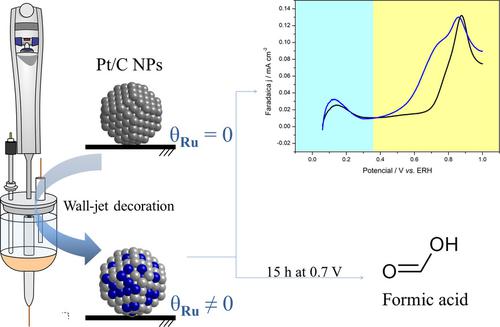当前位置:
X-MOL 学术
›
Electroanalysis
›
论文详情
Our official English website, www.x-mol.net, welcomes your
feedback! (Note: you will need to create a separate account there.)
Decorating Pt/C Nanoparticles with Ru by Wall‐Jet Configuration: The Role of Coverage Degree on the Catalyst Activity for Glycerol Electrooxidation
Electroanalysis ( IF 2.7 ) Pub Date : 2018-06-19 , DOI: 10.1002/elan.201800307 Leticia M. Alencar 1 , Cauê A. Martins 1
Electroanalysis ( IF 2.7 ) Pub Date : 2018-06-19 , DOI: 10.1002/elan.201800307 Leticia M. Alencar 1 , Cauê A. Martins 1
Affiliation

|
Here, we built Ru‐decorated Pt/C nanoparticles with different coverage degrees (θRu) by wall‐jet configuration for the first time, and we investigated their catalytic properties towards glycerol electrooxidation in acidic medium. Moreover, we used the most active catalysts as the anode in electrolysis to produce carbonyl compounds. The use of an electrochemical cell in wall‐jet configuration allows for the controlling of electrodeposition through easily handling parameters; namely, the θRu is controlled by changing the concentration of the metallic precursor, speed, and volume of injection onto a Pt/C‐modified glassy carbon electrode under applied potential. Excess of Ru on a Pt surface inhibits glycerol dissociative adsorption, which limits further electrooxidation; whereas low θRu do not provide surface oxygen species to the anodic reaction. Hence, intermediates θRu reveal active catalysts – namely, θRu=0.42 shifts the onset potential 170 mV towards lower values and increases 1.65‐fold the current density at 0.5 V. The stability of this catalyst is also enhanced by maintaining a more constant current density during successive potential cycles in the presence of glycerol and by avoiding Ru leaching from the surface. The electrolysis on Ru‐decorated Pt/C is shown to lead the reaction towards formic acid (‘high oxidation state’), decreasing the amounts of glyceradehyde, glycolic acid, and dihydroxyacetone, as a result of the improved catalytic properties.
中文翻译:

通过壁喷结构用Ru装饰Pt / C纳米颗粒:覆盖度对甘油电氧化催化剂活性的作用
在这里,我们建立的Ru-装饰的Pt / C纳米颗粒不同的覆盖度(θ孺)通过壁射流配置为在第一时间,和我们在酸性介质中研究了它们的催化性能对电氧化甘油。此外,我们在电解中使用活性最高的催化剂作为阳极来生产羰基化合物。在壁喷构造中使用电化学电池,可通过轻松处理参数来控制电沉积;即θ钌是通过改变金属前驱,速度和注入体积的浓度到下施加电势的Pt / C-修饰玻碳电极来控制。Pt表面上过量的Ru抑制了甘油的解离吸附,从而限制了进一步的电氧化。而低θRu不为阳极反应提供表面氧。因此,中间体θ孺揭示的活性催化剂-即,θ茹= 0.42的偏移开始电位170毫伏朝向较低的值,并增加在0.5 V.这种催化剂的稳定性的电流密度1.65倍,也通过保持更恒定的电流增强在存在甘油的情况下,在连续的潜在循环中保持密度,并避免Ru从表面浸出。钌修饰的Pt / C上的电解显示出可将反应引导至甲酸(“高氧化态”),由于改善的催化性能,减少了甘油醛,乙醇酸和二羟基丙酮的量。
更新日期:2018-06-19
中文翻译:

通过壁喷结构用Ru装饰Pt / C纳米颗粒:覆盖度对甘油电氧化催化剂活性的作用
在这里,我们建立的Ru-装饰的Pt / C纳米颗粒不同的覆盖度(θ孺)通过壁射流配置为在第一时间,和我们在酸性介质中研究了它们的催化性能对电氧化甘油。此外,我们在电解中使用活性最高的催化剂作为阳极来生产羰基化合物。在壁喷构造中使用电化学电池,可通过轻松处理参数来控制电沉积;即θ钌是通过改变金属前驱,速度和注入体积的浓度到下施加电势的Pt / C-修饰玻碳电极来控制。Pt表面上过量的Ru抑制了甘油的解离吸附,从而限制了进一步的电氧化。而低θRu不为阳极反应提供表面氧。因此,中间体θ孺揭示的活性催化剂-即,θ茹= 0.42的偏移开始电位170毫伏朝向较低的值,并增加在0.5 V.这种催化剂的稳定性的电流密度1.65倍,也通过保持更恒定的电流增强在存在甘油的情况下,在连续的潜在循环中保持密度,并避免Ru从表面浸出。钌修饰的Pt / C上的电解显示出可将反应引导至甲酸(“高氧化态”),由于改善的催化性能,减少了甘油醛,乙醇酸和二羟基丙酮的量。











































 京公网安备 11010802027423号
京公网安备 11010802027423号